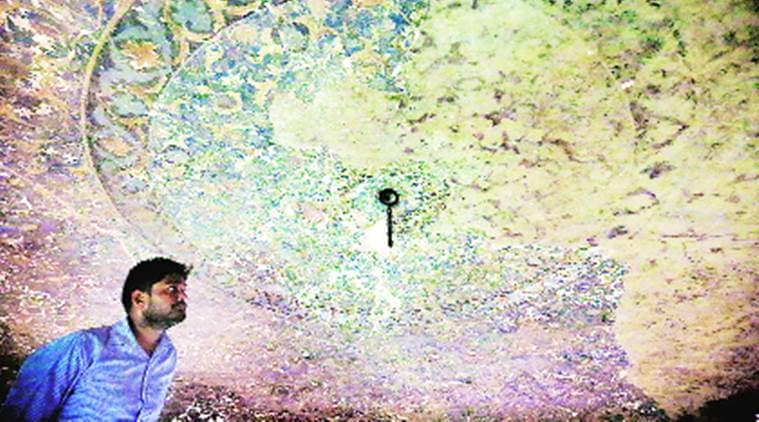 The tomb was built between 1530 and 1540 AD. Praveen Khanna
The tomb was built between 1530 and 1540 AD. Praveen Khanna
The ongoing conservation work at Sabz Burj, a 16th century double-domed tomb in the heart of the city, has revealed a floral painting on the ceiling. It was covered with layers of lime wash, the Aga Khan Trust for Culture (AKTC) has revealed.
“We found this a month ago and early analysis by an expert tells us that gold was used on the painting. We knew about paintings on the walls but did not know about the one on the ceiling,” said Ratish Nanda, project director, AKTC. Along with Archaeological Survey of India (ASI) and Havells, AKTC is conserving the tomb, which lies on the intersection of Mathura Road and Lodhi Road.
What’s truly striking about this discovery is that it strays away from the ornamental trends of the 16th century tombs. “The Nila Gumbad, Humayun’s Tomb, Sunder Burj and the Tomb of Abdur Rahim Khan-I-Khanan have incised plaster work on the ceiling. This one has a painting instead,” said Nanda.
An expert report submitted to AKTC states, “The dome spans an area of 36 metres, and the entire surface is painted… the ceiling has a dull grey aspect with discernible designs… 3/4th of the painted area is still visible.”
The painting, which is a bold floral design, has blue flowers and creepers. The red has turned blackish due to lime wash and pollution, while traces of gold can be seen on the vines, which have an overpaint of yellow and the outline is in black.
Nanda said, “The critical conservation challenge is to remove the inappropriate 20th century layers without losing the painting.” While work has begun on the painting, it will take another seven months to fully conserve it. “The painting is one of the inspirations behind Mughal carpets,” Nanda said.
The work on the tomb was expected to be over by 2018-end, but it is now likely to take another six months.
The tomb was built between 1530 and 1540 AD. It is the earliest example of Mughal architecture in Timurid style. Noted historian Ebba Koch, in her book Mughal Architecture (1991), wrote about the use of glazed tiles on the dome and commented that “it was popular in Iran”.
According to Radhika Chadha, Mughal history professor at Miranda House, “The painting on the ceiling could be Persian or central Asian influence…this became popular in Jahangir’s reign in the 17th century. This was, however, built much before that”.
Ever since the painting was discovered, AKTC has been looking for archival photographs of “the original plaster patterns on the facade which existed till the 1980s.”